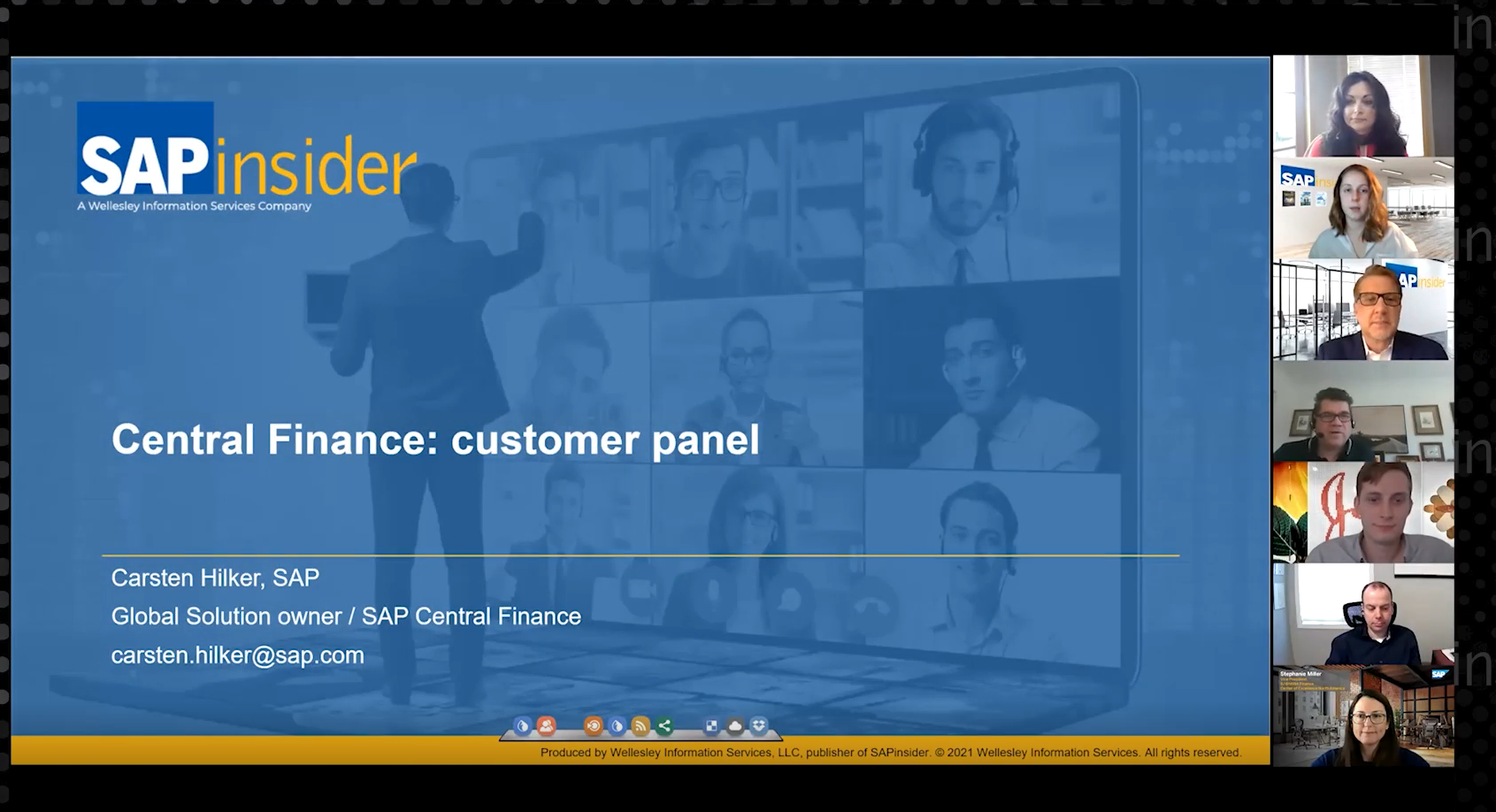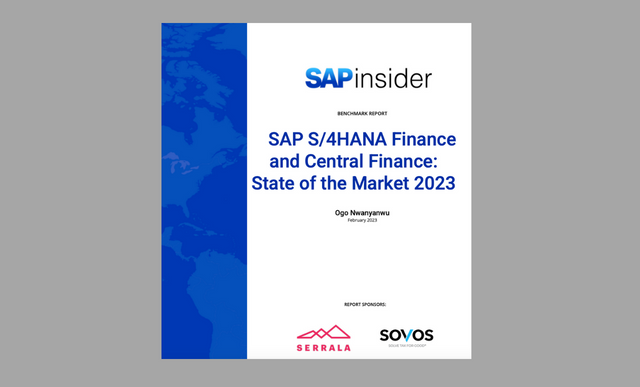A Fast Path to Innovation and Simplification with Central Finance
Transforming Business Without the Need for Upgrades
Over the last decade, enterprises have leveraged IT innovations in areas such as analytics, mobility, and in-memory computing to drive significant business process improvement. While some of these innovations are available as underlying technology components such as SAP HANA and SAP Fiori, they also have found their way into the SAP S/4HANA Finance solution — formerly known as SAP Simple Finance — which is natively built on SAP HANA to drive global financial transformation and dramatically simplify IT.
By reducing complexity in decision making, process execution, and IT architecture, SAP S/4HANA Finance enables finance organizations to completely reimagine business processes for the digital age. It does this by eliminating the need for experts to gather and prepare data for analysis, as well as the need for manual reconciliation between finance and controlling systems made necessary by batch operations. A lack of structural change in finance systems also meant a heavy reliance on IT to create a predefined system structure and perform follow-up reorganizations that hamper operational optimization. Having SAP HANA as the unifying engine running at the SAP S/4HANA Finance application layer dispenses with these familiar challenges, and enables a real-time soft close at any time. This simplification of finance operations is made possible with three key innovations:
- In-memory computing with SAP HANA enables OLTP and OLAP functions on one database, so that transactional data no longer has to be extracted, transformed, and loaded into OLAP, which became untenable for detailed reporting.
- Combining OLTP and OLAP on one database means a singular, logical view, so processes that have always involved more than one source — such as financial accounting (FI) and controlling (CO) — can be viewed as one, eliminating the need for error-prone reconciliations. This is a major improvement that significantly reduces process execution complexity.
- Combined with hardware advances that allow for systems that can accommodate even the most demanding data loads, columnar data storage dramatically boosts the performance of analytics by eliminating the need for secondary indices or summary tables and aggregates. This means augmented performance for both analytics and transactions without the need for duplicate data.
Transformation Without an Upgrade
If the number of SAP S/4HANA Finance customers is any indication — more than 2,000 in just a little more than a year after the solution’s release — finance organizations are eager to capitalize on its innovations and reimagine a host of finance and planning processes with a complete business transformation.
Explore related questions
Many other organizations are just as eager to take this step, but for one reason or another are reluctant or face temporary barriers to undertake the standard deployment path, which requires upgrading existing SAP ERP systems to SAP Business Suite powered by SAP HANA (along with a technical database migration to SAP HANA) and implementing SAP S/4HANA Finance for the finance portion.
For these organizations — ones with over-customized, single-system ERP implementations or with heterogeneous system landscapes consisting of several SAP and non-SAP ERP systems — there is a faster path to innovation: the Central Finance deployment scenario.
Central Finance is an accelerated, non-disruptive SAP S/4HANA Finance deployment option that replicates financial transactions from SAP and non-SAP ERP source systems onto a Central Finance instance that runs on SAP S/4HANA Finance. This provides a clear path toward the SAP S/4HANA Finance innovations without the need for a traditional upgrade.
In this scenario, unlike earlier replication efforts, data replication in Central Finance is on the application level rather than the database layer. Posting via standard SAP programs ensures that all underlying finance tables are updated at the same time and consistency, whereas at the database level this replication would occur one record or one table at a time. What this means is real-time and line-item-level replication with the option of on-the-fly data harmonization where required. Standard SAP authorizations ensure completeness and auditability of the Central Finance system, which, with legacy system status, is important for any external reporting out of the Central Finance instance.
Central Finance is an accelerated, non-disruptive SAP S/4HANA Finance deployment option that replicates financial transactions from SAP and non-SAP ERP source systems onto a Central Finance instance that runs on SAP S/4HANA Finance.
At its core, Central Finance is about consolidated entity reporting and central process execution. The reports and processes themselves depend in large part on specific customer requirements and challenges, the underlying business model, and the direction the business wants to take. While reporting and analytics are low risk and offer quick wins for an organization that wants to become familiar with SAP S/4HANA Finance, there are also a number of processes that can be implemented incrementally in a Central Finance instance. Processes such as record-to-report, as well as financial planning and analysis, are more straightforward to set up, while the finance portion of procure-to-pay and order-to-cash requires a review of the current and future state process design (that is, where the process ends in the source system and starts in Central Finance).
So while there is an implementation process to set up a Central Finance system — entailing basic set-up, customization, corresponding master data, and transactional data replication — this generally requires a fraction of the time and resources needed for a full-scale upgrade, and it can be rolled out incrementally based on the needs of the organization.
Enterprise-Wide Benefits
Because Central Finance offers a reconciled single source of truth for all data fed to non-SAP reporting, consolidation, and planning applications, all areas of finance stand to benefit from this deployment option before or without an upgrade. Data replication from multiple ERP source systems, SAP and non-SAP, provides strategic finance with advanced modeling and simulation capabilities with a fraction of the usual complexity. Additionally, strategic finance can far more easily tackle issues that arise from mergers and acquisitions. Corporate finance, likewise, will find dramatic simplification in reporting and planning and consolidation by using Central Finance to complement or even replace existing local reporting. With central process execution enablement, finance operations can drive simplicity in accounts payable (AP) and accounts receivable (AR) processes, as well as facilitate shared services.
Central process execution is a key differentiator that distinguishes Central Finance from the standard custom financial data warehouse — which for starters must be built. Standard data warehousing has limiting complexities such as having to interface source systems to non-SAP reporting, consolidation, and planning applications; perform periodic data transfers on an aggregated level; and provide redundant data storage resulting in a need for data validation and reconciliation.
With Central Finance, simplification is driven by a single source system connection to Central Finance; by real-time, line-item-level data; by centralized and governed mapping; and by drill-back to transaction details. With all finance transactions available as real finance postings in their respective tables, intercompany clearing in Central Finance enables planning processes to execute against the entire data set for scenarios such as expenses, orders, and profitability analysis.
From ownership, knowledge management, and centralization viewpoints, one system is clearly more tenable than multiple systems in a standard data warehousing scenario.
Use Cases for All Audiences
Central Finance is a deployment option aimed at enterprises not yet ready for a full SAP S/4HANA upgrade, or with multiple SAP and non-SAP ERP instances. Within this group of companies, we’ve found that there are three primary target audiences for Central Finance:
- The first Central Finance target audience is the enterprise that wants to quickly and with little risk reap the benefits of simplified reporting and analytics, and as a starting point experience SAP S/4HANA innovations at a low cost and with short time to value. We see many organizations currently looking at this scenario, even as they prepare for a full upgrade of the source systems in a more short-term fashion. With this approach, customers can get exposure to the new technology and capabilities and better prepare for the upgrade to the underlying source systems.
- The second target audience is a business that may already have gone through some consolidation effort, is now down to a handful of ERP systems, and is with relative certainty not going to consolidate more in the future. Central Finance provides this type of organization a fast path to innovation, consolidated reporting, and central process execution with short time to value. The deployment of Central Finance, however, does not negate the eventual upgrade to the source systems.
- Third is the organization with a pressing need for system consolidation. In this “lift-and-shift” scenario, companies can start benefitting from Central Finance by connecting source systems without disruption to the Central Finance instance (lift), and eventually migrate onto this instance (shift) and decommission the underlying source systems. This step includes logistics capabilities as well, and can be realized for SAP and non-SAP systems.
Beyond determining specific use cases, when considering the value of deploying Central Finance, organizations need to ask themselves: How long are we willing to wait for innovations in SAP S/4HANA, and where does that fit into current plans to consolidate multiple ERP source systems? To help answer these questions, it’s worth noting that because mapping a chart of accounts is a key part of consolidating source systems, more than a few customers are discovering that doing this harmonization work now takes it out of future consolidation efforts, thus allowing for faster ERP consolidations later as well as an opportunity to fine-tune those mapping efforts.
Regardless of how a finance organization intends to use Central Finance, one certainty is that the value increases when all stakeholders recognize that its various use cases span the breadth of finance. The business case isn’t based solely in reporting; it includes processes such as intercompany reconciliation, advanced planning, and financial data warehousing.
Shortening the Path to Innovation
With a rapid pace of innovation transforming business processes and business models, and even extending to solutions and technology infrastructures, organizations are often understandably hesitant to dive right into a newer solution that hasn’t been put through its paces, fearing it will become outdated entirely too soon.
This has not been the case with Central Finance, however, because SAP S/4HANA Finance enables such significant business transformation that organizations know that waiting carries too much risk. Central Finance shortens that path to business transformation by offering the SAP S/4HANA innovations with few of the resources required by a traditional ERP consolidation or full upgrade to SAP S/4HANA Finance. For more information, visit https://go.sap.com/services/finance.html.







